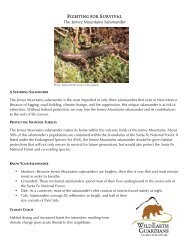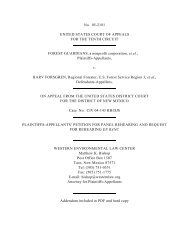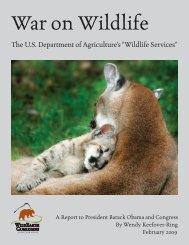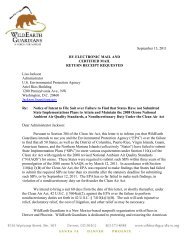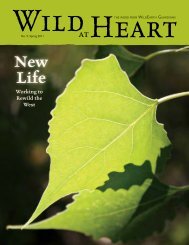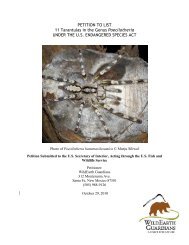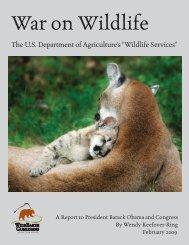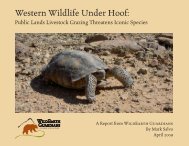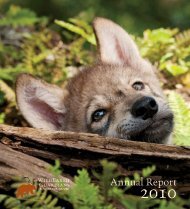PETITION TO LIST THE JEMEZ MOUNTAINS SALAMANDER ...
PETITION TO LIST THE JEMEZ MOUNTAINS SALAMANDER ...
PETITION TO LIST THE JEMEZ MOUNTAINS SALAMANDER ...
Create successful ePaper yourself
Turn your PDF publications into a flip-book with our unique Google optimized e-Paper software.
WildEarth Guardians Petition to List<br />
Jemez Mountains Salamander Under the ESA<br />
47<br />
The NMEST said that the impact to the Jemez Mountains salamander populations<br />
resulting from the Cerro Grande fire was of great concern (Borg 2001). Much of the<br />
salamander’s habitat burned and preliminary data analysis from three studies suggested a<br />
downward population trend. The NMEST stated, “Therefore, the remaining moderately<br />
burned and unburned habitat patches are of great importance to the short-term and longterm<br />
persistence of the Jemez Mountains salamander” (NMEST 2002b). The BAER<br />
(2000) report also stated that Jemez Mountains salamander may still persist within<br />
severely burned areas of the Cerro Grande fire where salamanders had previously<br />
occurred but were likely severely stressed due to disruption of preferred habitat (downed<br />
logs, bark), loss of forest canopy resulting in decreased humidity, and increased<br />
temperature of terrestrial and subterranean habitat, reduction or loss of invert prey, and<br />
siltation of interstitial spaces used to move to the surface. Information provided through<br />
FOIA requests does not indicate whether further mitigation steps were taken for the Valle<br />
II project to consider the cumulative impact the Cerro Grande fire and the Valle II<br />
treatment, but it is known that the funding requested for Jemez Mountains salamander<br />
habitat rehabilitation and monitoring after the Cerro Grande fire was not provided<br />
(NMEST 2002b).<br />
BMG/Lake Fires (2003)<br />
The Lakes and BMG wildfire timber salvage project was a controversial timber sale and<br />
resulted in federal litigation (Figures 4 and 8) (Johnson 2000; Armijo 2004). The USFS<br />
proposed to salvage approximately 890 acres in 11 units of the 4,641 acres that burned in<br />
the BMG and Lakes wildfires (Armijo 2004). The agency stated that more than 90% of<br />
the trees proposed for salvage would fall below 17” in diameter at breast height (dbh)<br />
averaging between 11-14 dbh. Approximately 73% of the fire-killed trees proposed to be<br />
harvested were ponderosa pine, 16% Douglas fir, and the remaining 11% white fir,<br />
limber pine, and spruce. The EA stated:<br />
The proposed salvage activities in the Lakes wildfire, primarily on Sandoval<br />
Ridge could cause disturbance to Jemez Mountains salamander habitat or<br />
inadvertently kill individual salamanders if they are present on the surface during<br />
salvage operations. The Jemez Mountains salamander is designated as a sensitive<br />
species. Salvage units in the Lakes wildfire are within potential salamander<br />
habitat and units 6-8 are within the Essential survey zone. Removing most of the<br />
fire-killed trees (snags) in these units would reduce the number of large down logs<br />
available for salamander habitat in the future.<br />
Even though the NMEST recommended Alternative 3 and had strong reservations about<br />
the negative effects the proposed salvage sale would have on Jemez Mountains<br />
salamander populations and habitat, and the EA itself acknowledged the threats posed by<br />
the salvage project, the preferred alternative (Alternative 2) was still carried out. Some,<br />
but not all, mitigation measures recommend by the NMEST were incorporated into the<br />
final timber salvage sale guidelines. Members of the NMEST had multiple concerns over<br />
the Lakes/BMG salvage sale and the preferred Alternative 2. These included, for



